In this article, we are going to embark on a flavorful journey through two beloved Indian dishes: Palak Paneer and Paneer Tikka Masala.
These vegetarian delights are renowned for their rich flavors, creamy textures, and the starring role of paneer, a versatile Indian cheese.
Whether you’re a fan of the vibrant green hues and earthy flavors of Palak Paneer or the smoky grilled paneer and tangy tomato-based gravy of Paneer Tikka Masala, this article has got you covered.
Let us dive into the delicious debate of Palak Paneer vs Paneer Tikka Masala, comparing and contrasting their distinct characteristics, differences, and similarities.

Table Showing the Differences Between Palak Paneer and Paneer Tikka Masala
| Factors | Palak Paneer | Paneer Tikka Masala |
|---|---|---|
| Origin | North Indian Cuisine | Punjabi Cuisine |
| Color | Vibrant green | Rich red |
| Flavor | Earthy, mildly spiced | Robust, smoky, tangy |
| Texture | Creamy, velvety | Grilled, slightly chewy |
| Ingredients | Spinach, paneer, spices | Paneer, tomato, spices |
| Availability of Ingredients | Widely available | Widely available |
| Paneer Used | Soft and fresh | Firmer, grilled |
| Cooking Time | Relatively quick | Requires more time |
| Method of Cooking | Simmering and pureeing spinach | Marinating, grilling, simmering |
| Serving | Main course | Part of a larger spread |
| Nutritional Value (per serving)* | Calories: Low-Moderate | Calories: Moderate-High |
| Protein: High | Protein: High | |
| Carbohydrates: Low | Carbohydrates: Moderate | |
| Fiber: High | Fiber: Low |
A Brief Overview of Palak Paneer

Let’s start our culinary journey with Palak Paneer, a vibrant and wholesome dish that combines the goodness of spinach (palak) with the rich creaminess of paneer.
Palak Paneer is a staple in North Indian cuisine and is known for its nutritious and flavorsome qualities.
In this dish, fresh spinach leaves are blanched and then pureed to create a vibrant green base.
The pureed spinach is then cooked with aromatic spices like cumin, coriander, and garam masala, which lend it a distinctive flavor profile.
The star of the dish, paneer, is cubed and lightly fried before being simmered in the spinach gravy.
The combination of the creamy paneer and the earthy spinach creates a delightful contrast of textures and flavors.
Palak Paneer is not only delicious but also packed with essential nutrients.
Spinach is a great source of iron, calcium, and vitamins, making this dish a healthy choice for vegetarians and vegans.
It pairs wonderfully with naan bread, roti, or fragrant basmati rice, making it a wholesome and satisfying meal.
A Brief Overview of Paneer Tikka Masala

Now, let’s turn our attention to Paneer Tikka Masala, a mouthwatering dish that showcases the aromatic flavors of Indian spices and the succulent goodness of paneer.
Paneer Tikka Masala is a popular vegetarian alternative to the classic chicken tikka masala, and it never fails to impress with its tantalizing blend of flavors.
The preparation of Paneer Tikka Masala involves marinating paneer cubes in a mixture of yogurt, spices, and lemon juice.
The marinated paneer is then grilled until it acquires a beautiful charred exterior and a tender, melt-in-your-mouth texture.
These delectable paneer tikka pieces are then simmered in a rich tomato-based gravy, infused with a medley of aromatic spices like cumin, coriander, turmeric, and garam masala.
The resulting dish is a symphony of flavors that is both tangy and mildly spicy, with a hint of smokiness from the grilled paneer.
The combination of the creamy tomato gravy and the succulent paneer chunks makes Paneer Tikka Masala a true crowd-pleaser.
Difference between Palak Paneer and Paneer Tikka Masala (Detailed breakdown)

In this section, we’ll dive deeper into the key differences between these delightful dishes.
From their origins to their color, texture, ingredients, cooking time, method of cooking, nutritional value, and flavor profiles, we’ll unravel the unique characteristics that make them stand out. So, let’s get started!
Differences in the Origin
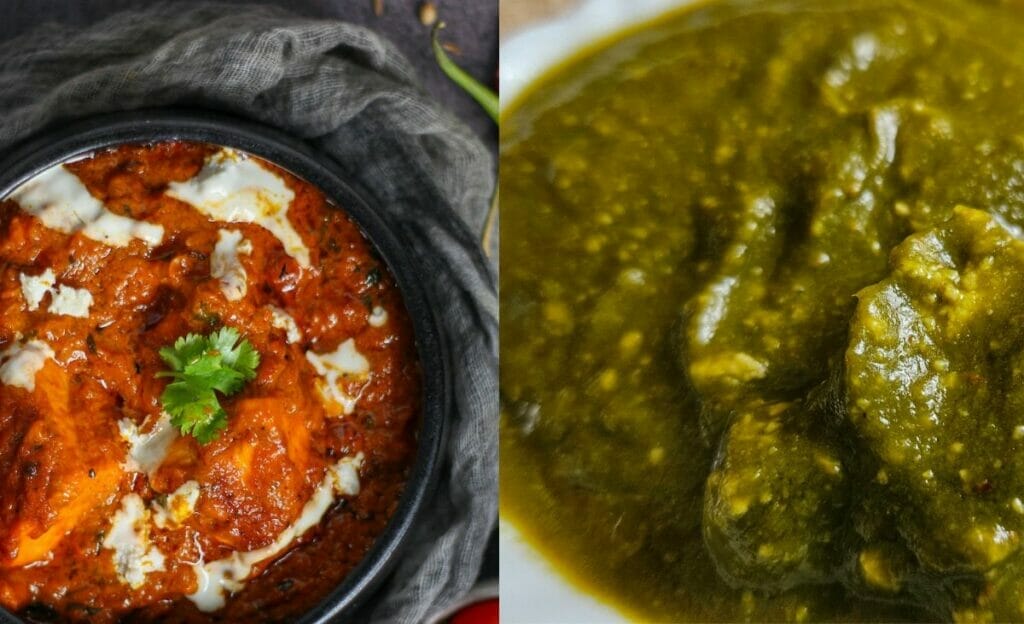
Palak Paneer and Paneer Tikka Masala hail from different culinary traditions in India.
Palak Paneer originated in the northern regions of the country, where spinach (palak) is abundant.
The dish showcases the use of leafy greens and is deeply rooted in the vegetarian cuisine of North India.
On the other hand, Paneer Tikka Masala finds its roots in Punjabi cuisine, which is renowned for its rich and robust flavors.
This dish evolved from the popular chicken tikka masala and has become a beloved vegetarian alternative.
Differences in the Color
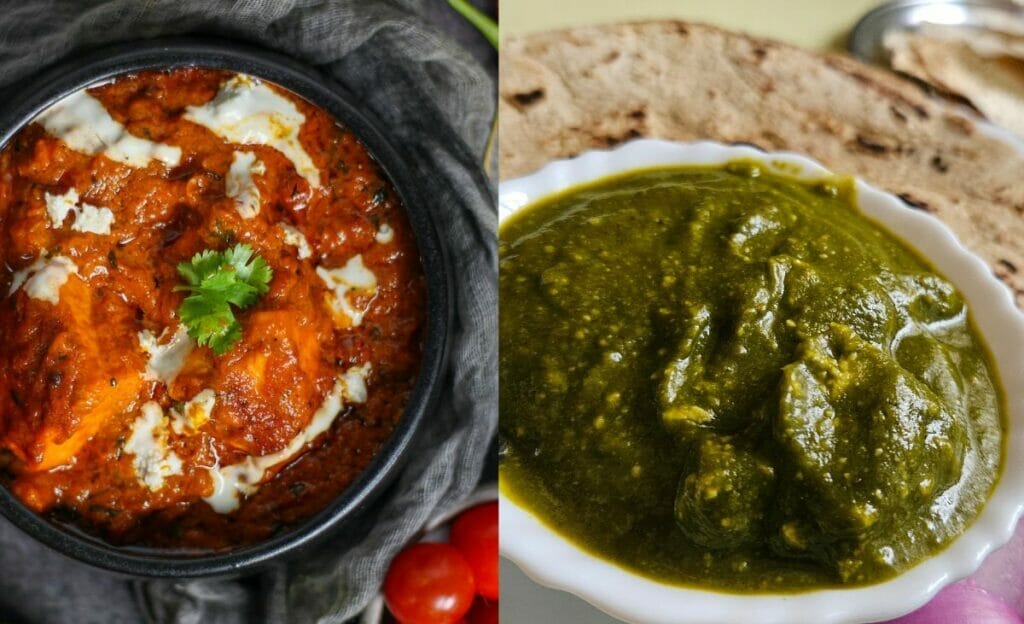
One of the striking differences between Palak Paneer and Paneer Tikka Masala lies in their vibrant colors.
Palak Paneer features a vibrant green hue thanks to the generous use of fresh spinach. The bright green gravy creates an appetizing visual appeal that is both inviting and refreshing.
In contrast, Paneer Tikka Masala exhibits a rich red color owing to the tomato-based gravy infused with a blend of spices. The alluring red tone adds a sense of warmth and depth to the dish.
Differences in Flavor
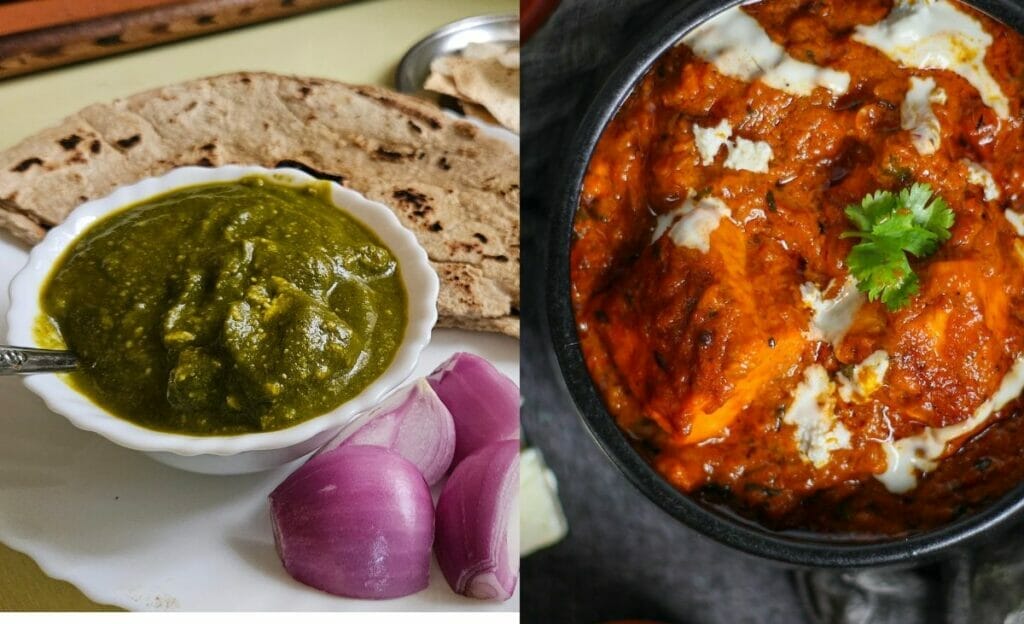
When it comes to flavor, Palak Paneer and Paneer Tikka Masala offer distinct taste experiences.
Palak Paneer boasts earthy and mildly spiced flavors. The blend of spinach, aromatic spices, and the creaminess of paneer creates a harmonious combination that is both comforting and satisfying.
The dish has a subtle hint of bitterness from the spinach, which is balanced by the creaminess of the paneer.
On the other hand, Paneer Tikka Masala presents a bolder flavor profile. The marinated and grilled paneer brings a smoky and slightly charred taste to the dish.
The tomato-based gravy is tangy and packed with a medley of spices, such as cumin, coriander, and garam masala. The flavors are robust, spicy, and indulgent, creating a delightful explosion on the palate.
Difference in the Texture
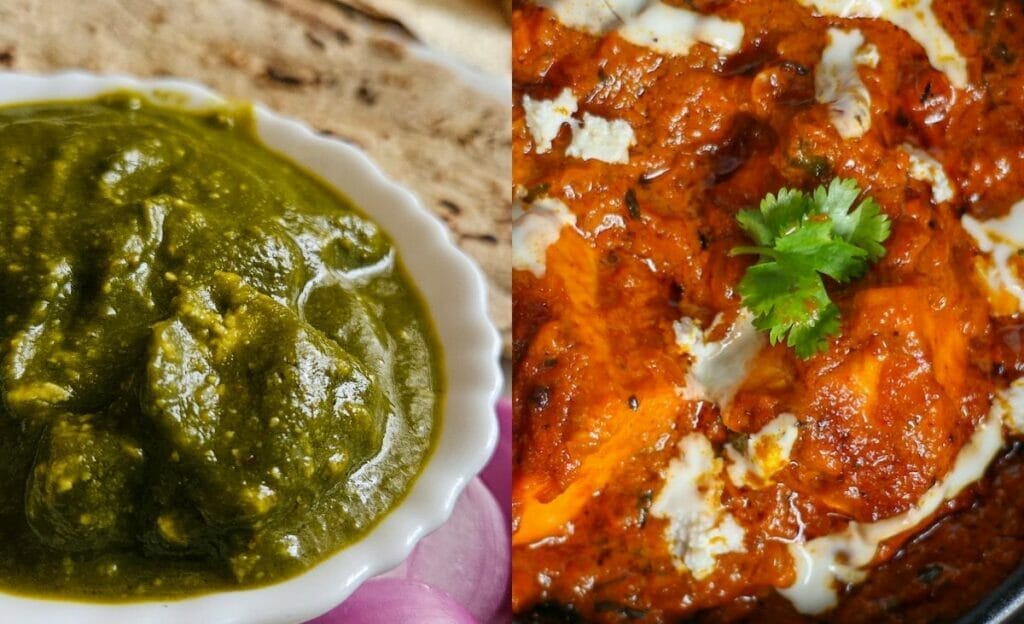
One noticeable difference between Palak Paneer and Paneer Tikka Masala lies in their textures. Palak Paneer showcases a creamy and velvety consistency thanks to the pureed spinach base and the soft, melt-in-your-mouth paneer cubes.
The spinach imparts a smoothness to the dish, creating a luscious experience on your palate. Each bite offers a harmonious blend of creaminess and tenderness.
In contrast, Paneer Tikka Masala offers a contrast in textures. The grilled paneer cubes in Paneer Tikka Masala bring a slight firmness and a charred exterior to the dish. This adds a delightful bite and a smoky element that enhances the overall experience.
The paneer pieces remain tender and juicy on the inside, providing a satisfying contrast to the rich and flavorful tomato-based gravy.
Difference in the Ingredients

Palak Paneer and Paneer Tikka Masala differ not only in texture but also in the ingredients they showcase.
Palak Paneer primarily highlights the combination of fresh spinach and paneer.
The dish is complemented by a blend of spices such as cumin, coriander, garam masala, and turmeric, which add depth and aroma to the spinach gravy.
The result is a wholesome dish that celebrates the goodness of leafy greens and the creamy indulgence of paneer.
On the other hand, Paneer Tikka Masala incorporates a wider variety of ingredients.
The marinade for the paneer includes yogurt, spices like cumin, coriander, and chili powder, along with lemon juice for a tangy touch.
The tomato-based gravy is enriched with spices such as cumin, coriander, turmeric, garam masala, and sometimes kasuri methi (dried fenugreek leaves).
The combination of these ingredients creates a robust and flavorful profile, perfectly complementing the grilled paneer.
Difference in the Availability of Ingredients
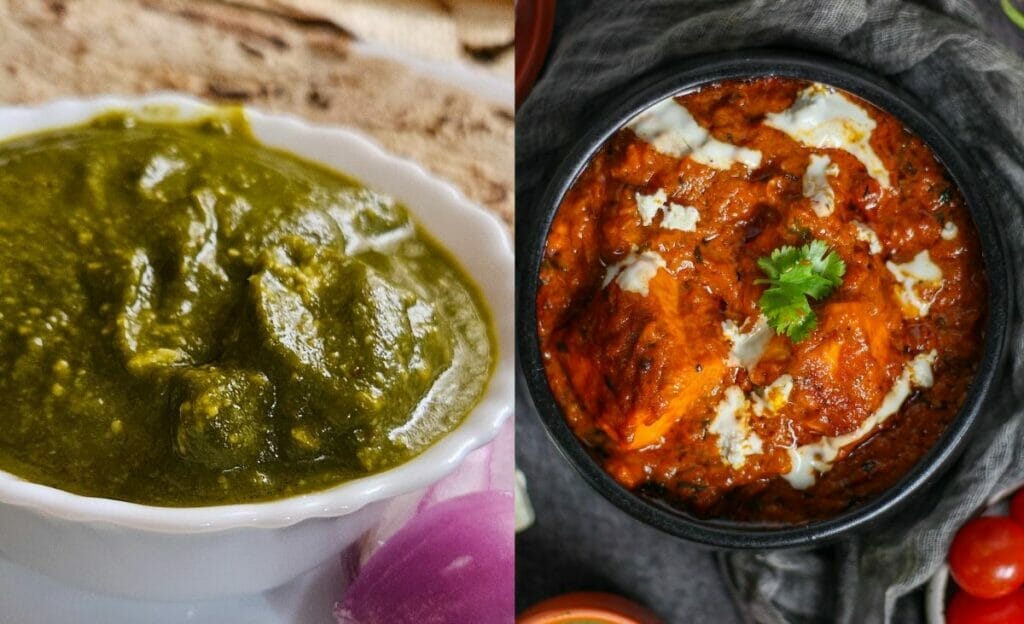
When it comes to the availability of ingredients, both Palak Paneer and Paneer Tikka Masala have their unique considerations.
Palak Paneer relies heavily on fresh spinach, which is usually widely available in grocery stores and farmers’ markets.
Paneer, a versatile Indian cheese, can also be found in many supermarkets or can be made at home using milk.
For Paneer Tikka Masala, apart from paneer, the dish requires tomatoes, onions, and a range of spices.
These ingredients are generally accessible in most places, making it easier to recreate the flavors of this dish.
However, certain spices like kasuri methi might be slightly harder to find in some locations, but they can often be substituted with other aromatic herbs or left out without compromising the overall taste.
Difference in the Paneer Used in Both Recipes
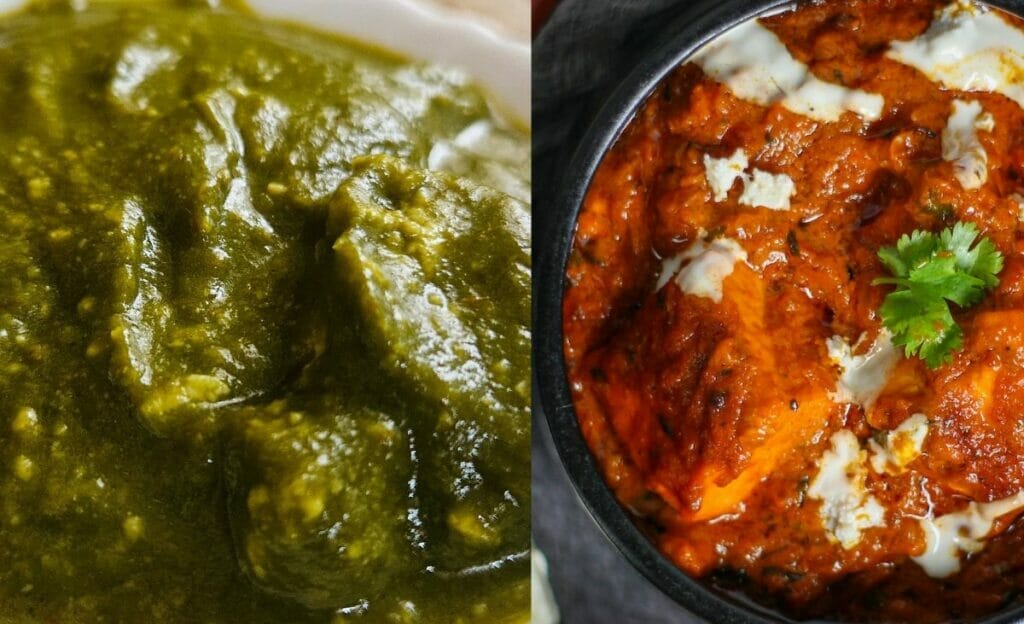
Palak Paneer and Paneer Tikka Masala showcase variations in the type of paneer utilized.
In Palak Paneer, the paneer cubes are typically soft and fresh, retaining their delicate texture throughout the cooking process. The tender paneer adds a delightful creaminess to the dish, perfectly complementing the vibrant spinach gravy.
On the other hand, Paneer Tikka Masala takes a slightly different approach. The paneer used in this dish is often firmer and drier.
Before incorporating it into the dish, the paneer cubes are marinated and grilled, which adds a smoky flavor and a slightly chewier texture. This distinct type of paneer holds up well during the cooking process and stands out as a highlight in the final dish.
Difference in the Cooking Time
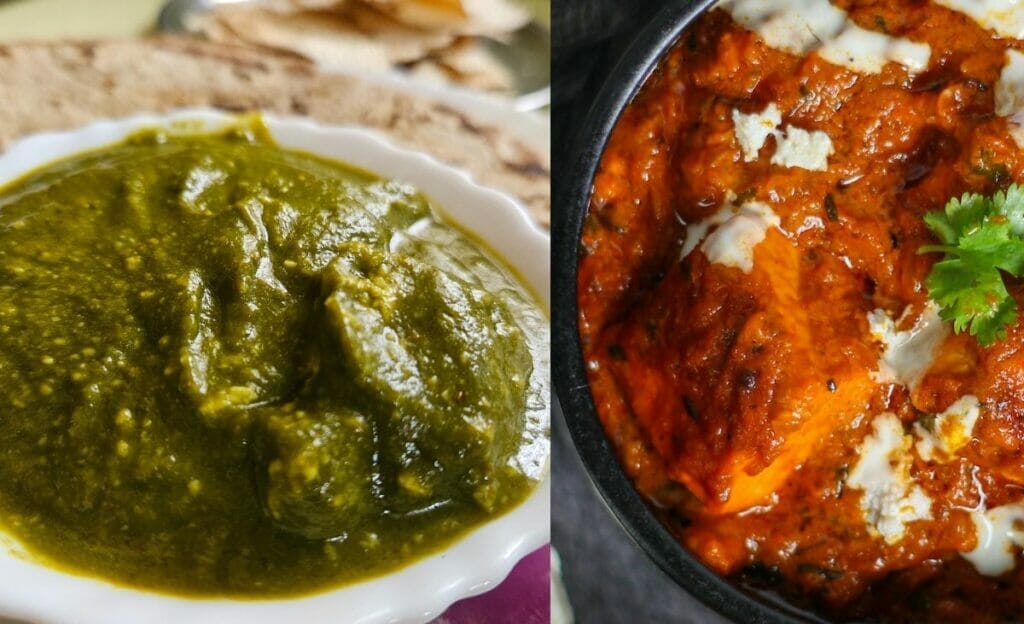
When it comes to cooking time, Palak Paneer and Paneer Tikka Masala differ in their preparation and execution.
Palak Paneer is generally a quicker dish to make. Once the spinach is blanched and pureed, it is cooked along with the spices and other ingredients, and the paneer is added towards the end. The dish comes together in a relatively short time, making it an excellent choice for a satisfying weeknight meal.
In contrast, Paneer Tikka Masala requires a bit more time and effort. First, the paneer cubes are marinated and then grilled until they acquire a desirable texture and charred flavor.
Afterward, they are simmered in a tomato-based gravy infused with spices, allowing the flavors to meld together. This additional step of grilling the paneer and the subsequent simmering of the dish takes a bit more time, making Paneer Tikka Masala a dish that demands a little more patience and attention.
Difference in the Method of Cooking

The method of cooking Palak Paneer and Paneer Tikka Masala showcases distinct techniques.
Palak Paneer involves blanching the spinach, followed by pureeing it to create a smooth and vibrant green base. The pureed spinach is then cooked with spices and other ingredients, and finally, the paneer is added to the simmering gravy. This process ensures that the flavors infuse into the dish while keeping the paneer soft and delicate.
Paneer Tikka Masala, on the other hand, involves a multi-step process. The paneer cubes are marinated with spices and yogurt, then grilled or cooked in a tandoor (traditional clay oven) until they develop a charred exterior and a smoky flavor.
The grilled paneer is then added to the tomato-based gravy, allowing it to absorb the rich flavors and become tender. This method imparts a distinct taste and texture to the dish, making it a flavorful and visually appealing experience.
Difference in the Serving
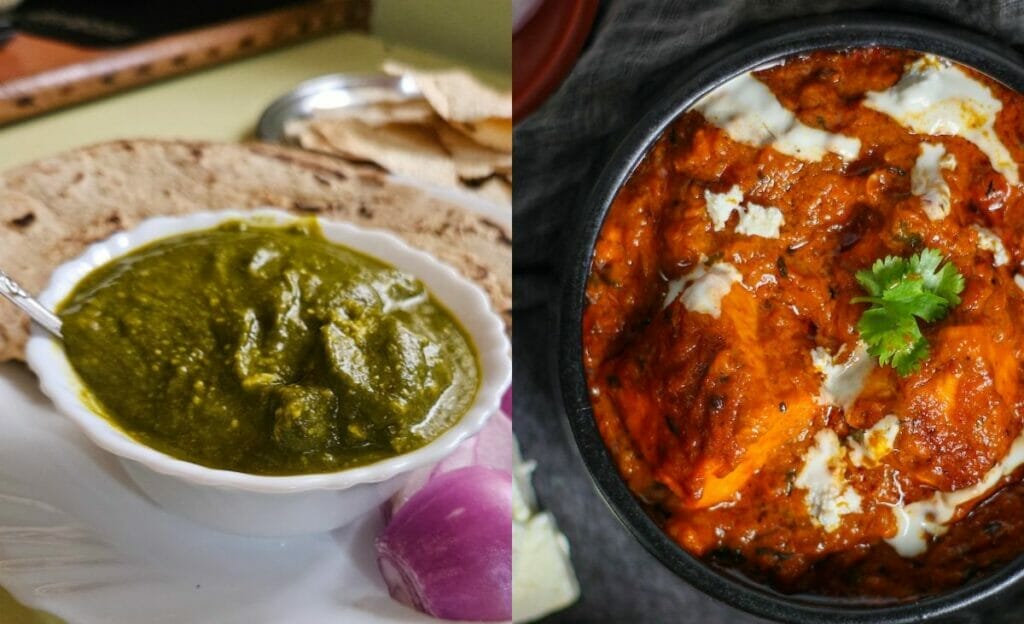
Palak Paneer and Paneer Tikka Masala showcase different serving styles that add to their individual charm.
Palak Paneer is typically served as a main course, accompanied by bread such as naan, roti, or rice.
The creamy green gravy of Palak Paneer, with the soft paneer cubes nestled within, becomes the star of the dish. It’s a visually appealing delight that pairs well with the bread or rice, creating a satisfying and wholesome meal.
On the other hand, Paneer Tikka Masala is often presented as a part of a larger spread or as a centerpiece in a thali (a traditional Indian platter). It is typically accompanied by other dishes such as rice, naan, or various Indian breads, along with side dishes and condiments.
Paneer Tikka Masala, with its vibrant red gravy and grilled paneer, adds a burst of color and flavor to the overall presentation, creating a festive and indulgent experience.
Difference in the Nutritional Value
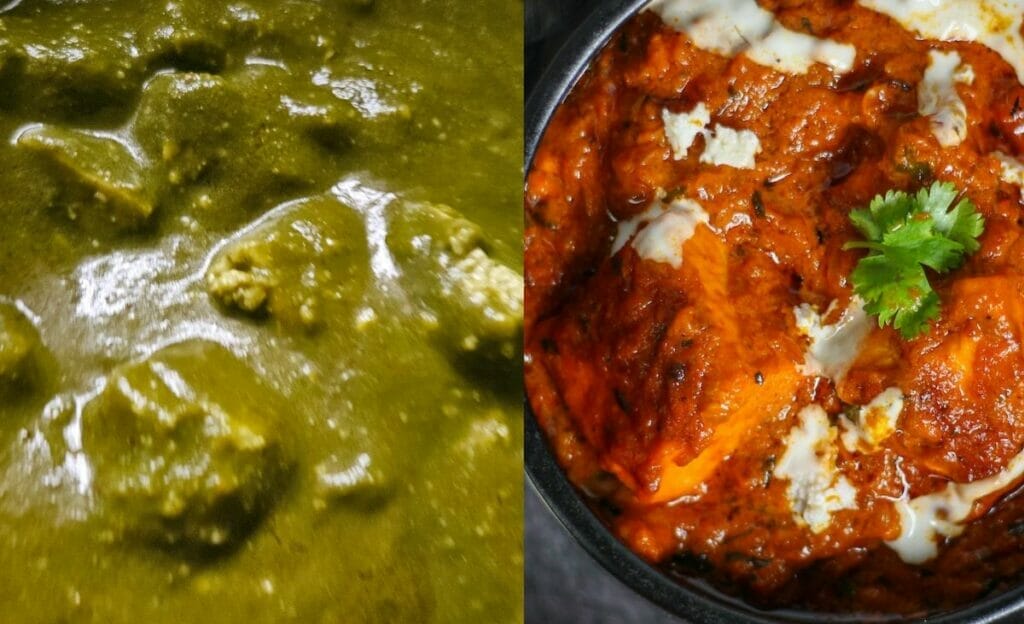
Palak Paneer and Paneer Tikka Masala differ in their nutritional composition, offering distinct benefits.
Let’s take a closer look at the key nutritional aspects:
Calories:
Palak Paneer tends to be lower in calories compared to Paneer Tikka Masala. The use of spinach as the base in Palak Paneer, along with its high water content, contributes to a relatively lower calorie count.
Protein:
Both dishes are excellent sources of protein, thanks to the paneer cubes. Paneer is rich in casein protein, which is known for its slow digestion and sustained release of amino acids.
Carbohydrates:
Paneer Tikka Masala often contains a slightly higher carbohydrate content due to the tomato-based gravy and possible addition of onions. Palak Paneer, being primarily spinach-based, contains fewer carbohydrates.
Fiber:
Palak Paneer offers a higher fiber content due to spinach, which is rich in dietary fiber. Paneer Tikka Masala may have lower fiber content, depending on the ingredients used in the gravy.
Overall, both dishes provide valuable nutrients and can be incorporated into a balanced diet. The specific nutritional values may vary based on the recipe and serving size.
Similarities Between Palak Paneer and Paneer Tikka Masala

While Palak Paneer and Paneer Tikka Masala have their distinct characteristics, they also share some delightful similarities that make them favorites among paneer lovers.
In this section, we’ll explore the common ground they stand on and the aspects that bring them together.
Let’s dive in!
Creamy Paneer

Both Palak Paneer and Paneer Tikka Masala feature the star ingredient, paneer, a soft and creamy Indian cheese.
Whether it’s nestled in the vibrant green spinach gravy of Palak Paneer or grilled and added to the rich tomato-based gravy of Paneer Tikka Masala, the creamy goodness of paneer remains a consistent and delightful element in both dishes.
Its velvety texture and ability to absorb flavors make it a perfect canvas for the aromatic spices and sauces.
Aromatic Spices

Another shared characteristic between Palak Paneer and Paneer Tikka Masala is the generous use of aromatic spices that create their distinct flavors.
While the specific spice blends may vary, both dishes rely on spices like cumin, coriander, garam masala, and turmeric to infuse depth and complexity into the preparation.
These spices not only enhance the taste but also contribute to the rich aroma that fills the kitchen while cooking these dishes.
Vegetarian Delights

Both Palak Paneer and Paneer Tikka Masala are delightful vegetarian recipes in Indian cuisine.
These paneer-based creations provide a satisfying and flavorful option for those who prefer vegetarian or meatless meals.
The versatility of paneer allows it to be the hero of the dish, offering a protein-rich and satisfying alternative for vegetarians and paneer enthusiasts alike.
Popular Indian Cuisine

Palak Paneer and Paneer Tikka Masala are both quintessential dishes in Indian cuisine. They have become staples not only in Indian households but also in Indian restaurants around the world.
The popularity of these dishes speaks to their ability to please palates across cultures and to represent the rich culinary heritage of India.
Whether you’re exploring Indian cuisine for the first time or are already a fan, these dishes are sure to offer a taste of the vibrant and diverse flavors that Indian food has to offer.
How to make Palak Paneer recipe (Video)
How to make Paneer Tikka Masala recipe (Video)
What is the difference between paneer tikka and paneer masala?
Paneer tikka and paneer masala are two distinct preparations of paneer, the star ingredient. Paneer tikka refers to marinated paneer cubes that are skewered and grilled, usually in a tandoor (clay oven) or on a stovetop. It is known for its smoky flavor and charred exterior.
On the other hand, paneer masala refers to paneer cooked in a rich, spiced tomato-based gravy. The gravy imparts a tangy, spicy, and creamy flavor to the dish.
While both dishes feature paneer, they differ in their cooking methods and flavor profiles.
What is the difference between paneer and Palak paneer?
Paneer is a versatile Indian cheese made from curdling milk and separating the curds from the whey. It is a key ingredient in many Indian dishes, including Palak Paneer.
Palak Paneer is a specific preparation where paneer is cooked in a smooth and vibrant spinach gravy. The addition of spinach adds an earthy flavor and a vibrant green color to the dish.
In essence, paneer is the cheese itself, while Palak Paneer refers to the combination of paneer and spinach gravy.
Which is best: paneer tikka or paneer butter masala?
The preference between paneer tikka and paneer butter masala ultimately depends on personal taste.
Paneer tikka offers a smoky and charred flavor due to the grilling process, while paneer butter masala boasts a rich, creamy tomato-based gravy.
Paneer tikka is a popular appetizer or snack, while paneer butter masala is a main course dish often enjoyed with naan or rice.
Both dishes have their own unique appeal, so it’s best to try both and decide which one satisfies your cravings the most.
Which type of paneer is best?
The best type of paneer is subjective and can vary based on personal preferences and the specific recipe being prepared.
Generally, fresh and soft paneer is preferred for dishes like Palak Paneer, where a tender texture is desired.
For dishes like paneer tikka, a firmer paneer that can hold its shape during grilling is preferred. Ultimately, it comes down to the specific dish you’re making and the desired texture you want the paneer to have.
Is paneer tikka healthy or unhealthy?
Paneer tikka can be a healthy choice depending on the cooking method and ingredients used. Grilled paneer itself is a good source of protein, while the marinade can vary in terms of its healthiness.
Using a yogurt-based marinade with minimal oil and incorporating spices like turmeric, ginger, and garlic can enhance the nutritional value.
However, if the paneer is heavily marinated in high-fat ingredients and grilled with excessive oil, it can increase the calorie content.
Moderation and mindful ingredient choices can help make paneer tikka a healthy and delicious option.
Why is Palak Paneer so good?
Palak Paneer is beloved for several reasons. Firstly, the combination of the creamy paneer and the earthy spinach creates a delightful contrast of flavors and textures.
The spices used, such as cumin, coriander, and garam masala, add depth and aroma to the dish.
Additionally, Palak Paneer is packed with essential nutrients. Spinach is rich in iron, calcium, vitamins, and dietary fiber, making it a healthy choice.
Its vibrant green color is visually appealing and adds to the overall experience of enjoying this delicious dish.
Is tikka and masala the same thing?
No, tikka and masala are not the same thing. Tikka refers to marinated and grilled pieces of meat or vegetables, such as paneer, while masala refers to a spice blend or a dish cooked in a rich, spiced gravy.
In the case of paneer tikka, the paneer cubes are marinated and grilled, while paneer masala involves cooking paneer in a tomato-based gravy with a blend of spices.
The terms tikka and masala represent different cooking techniques and flavor profiles.
Why is it called paneer tikka?
The term “paneer tikka” originated from the Hindi language.
“Paneer” refers to the Indian cheese made from milk, and “tikka” is a word used for small pieces or chunks. Paneer tikka, therefore, translates to “small chunks of paneer.”
The name aptly describes the dish, as it consists of marinated and grilled paneer cubes, resulting in flavorful and succulent bites.
Which is spicier: Palak paneer or paneer tikka masala?
In terms of spiciness, paneer tikka masala is typically spicier compared to Palak Paneer.
Paneer tikka masala often includes a blend of spices like cumin, coriander, chili powder, and garam masala, which contribute to its fiery flavor.
Palak Paneer, on the other hand, can be milder in terms of spiciness, as the focus is more on the earthy flavors of spinach and aromatic spices rather than intense heat.
However, the level of spiciness can be adjusted according to personal preference in both dishes.
Which is healthier: Palak paneer or paneer tikka masala?
Both Palak Paneer and Paneer Tikka Masala offer nutritional benefits, but their healthiness may vary based on the specific recipe and ingredients used.
Palak Paneer, with its spinach base, is rich in iron, calcium, vitamins, and fiber. It is a nutritious choice, especially when prepared with minimal oil and healthy cooking methods.
Paneer Tikka Masala, while providing protein from paneer, can be higher in calories and fat due to the tomato-based gravy and potential use of cream or butter.
Moderation and mindful ingredient choices are key to enjoying the health benefits of both dishes.
Which is better: Palak paneer or paneer tikka masala?
Deciding which is better, Palak Paneer or Paneer Tikka Masala, is a matter of personal preference.
Palak Paneer is a wholesome and comforting dish, featuring a creamy spinach gravy that pairs well with bread or rice. It is a great option for those seeking a nutritious and satisfying meal. Paneer Tikka Masala, with its smoky grilled paneer and rich tomato-based gravy, offers a bolder and indulgent flavor profile. It is a popular choice for those who enjoy tangy and spicy dishes. Both dishes have their own unique qualities, so the “better” option depends on individual taste and craving.
Conclusion
In conclusion, the comparison between Palak Paneer and Paneer Tikka Masala reveals the unique characteristics that make each dish a culinary delight. From the vibrant green color and earthy flavors of Palak Paneer to the smoky grilled paneer and rich tomato-based gravy of Paneer Tikka Masala, these dishes offer distinct experiences that showcase the versatility of paneer in Indian cuisine.
Throughout this article, we’ve explored various aspects, including the differences in origin, color, flavor, texture, ingredients, cooking time, method of cooking, serving style, nutritional value, and more.
We’ve also addressed common questions and debates surrounding these dishes, providing insights into their similarities and differences.
If you’re curious about the origins of these dishes, their unique flavors, the best type of paneer to use, the nutritional aspects, or even the spiciness levels, we’ve covered it all.
Whether you’re a fan of the creamy goodness of Palak Paneer or the bold and smoky flavors of Paneer Tikka Masala, this article offers a comprehensive understanding of what sets these dishes apart.
So, if you’re eager to expand your knowledge and indulge in the flavors of these beloved Indian dishes, I encourage you to read the full article.
Uncover the delightful nuances, discover your personal preference, and embark on a culinary adventure through the world of Palak Paneer and Paneer Tikka Masala.
Happy cooking!
